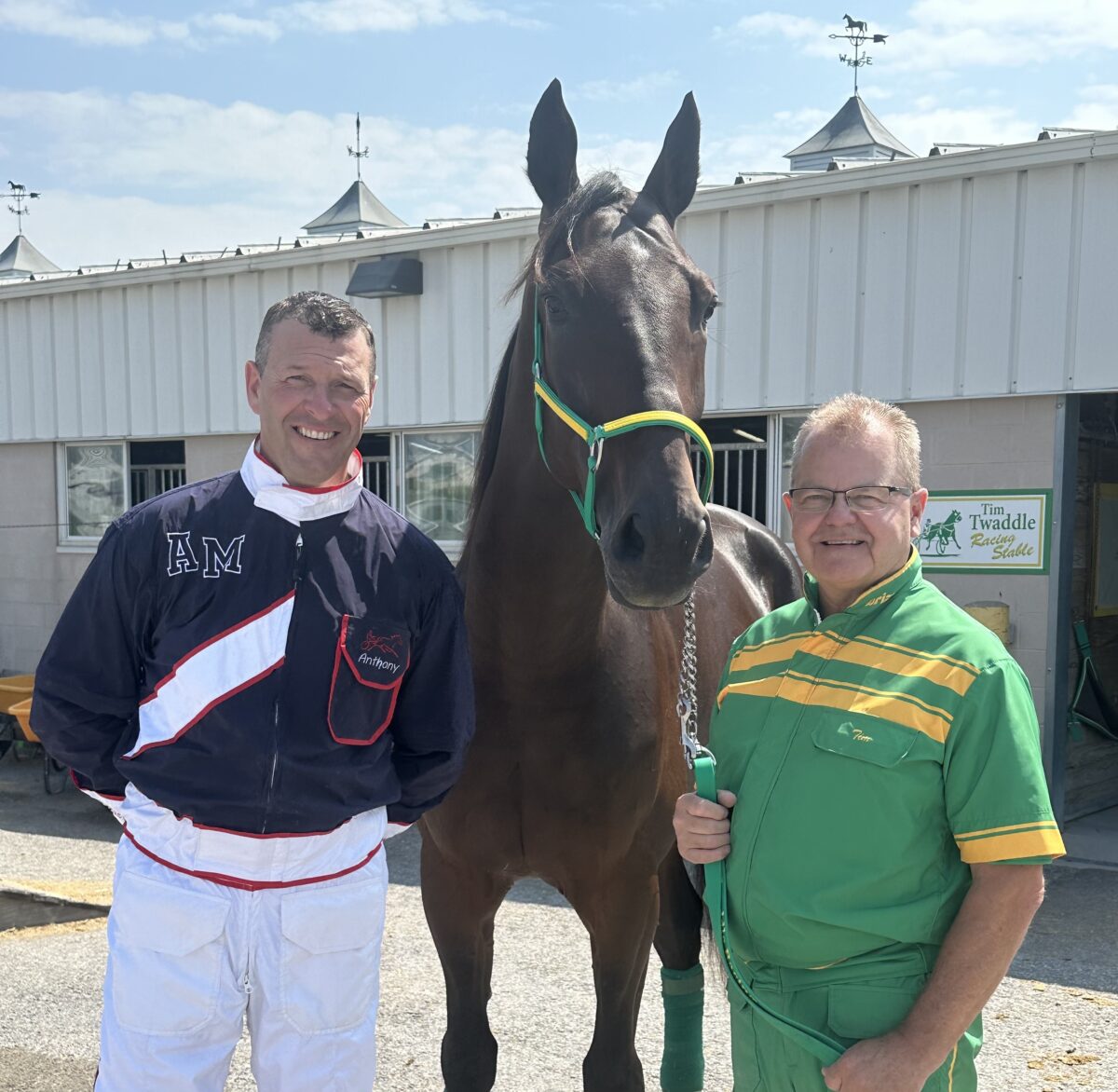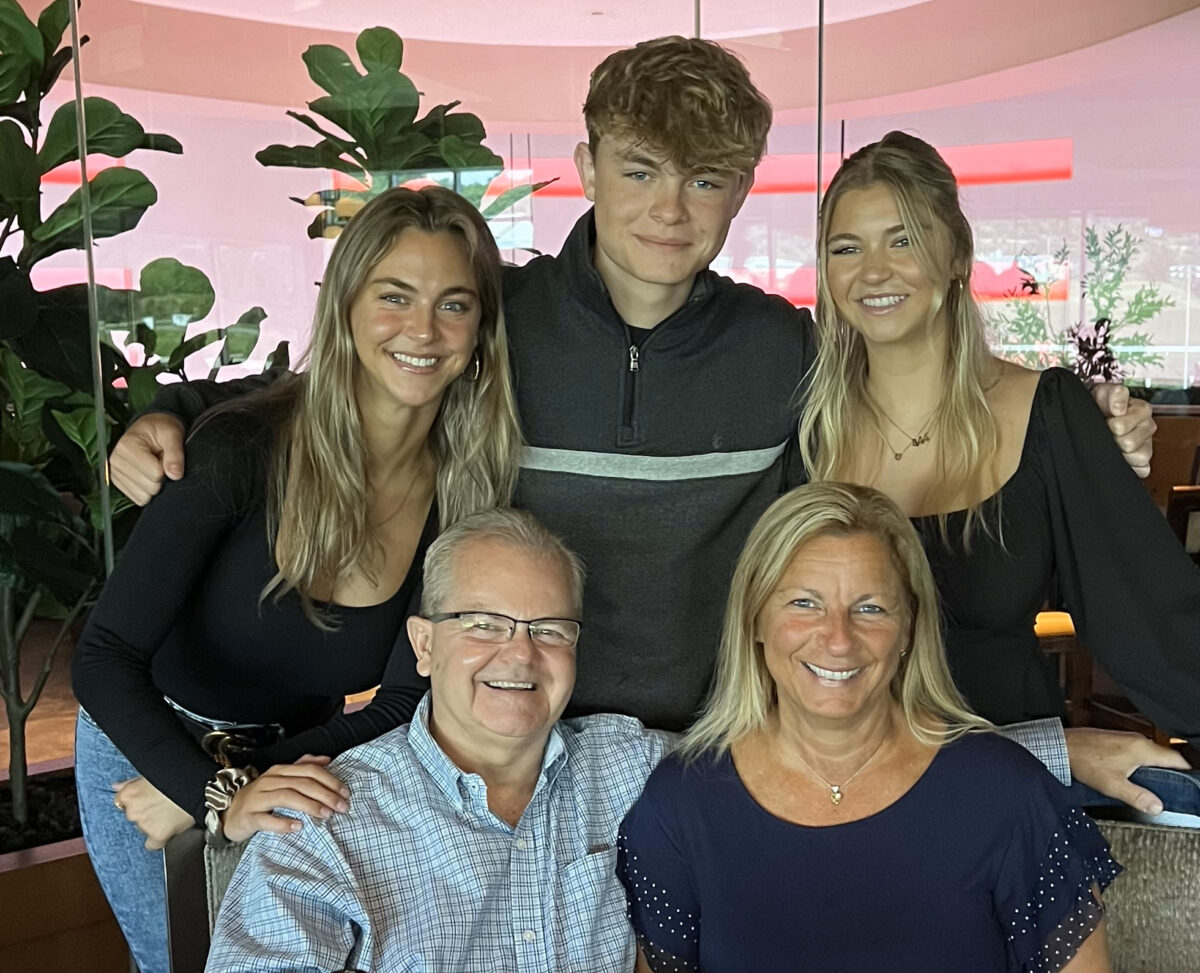The three phases of Tim Twaddle
by Murray Brown
It is difficult for this observer to accept the fact that Tim Twaddle is now 62 years old. When I think of him, I recollect a kid, a teenager who is earning his spurs driving some of the outstanding horses for John Burns – horses like Shipps Schnoops, Shipps Fella, Towners Image and Hardie Hanover. Where has the time gone? Twaddle is now in likely the last phase of what might be called, at least geographically, a three-staged career in harness racing.
It began when he was only 9 years old as a part-time employee of the Bill Carroll stable at the now defunct Garden City Racetrack in St Catharines, ON then part of the Ontario Jockey Club (OJC); now WEG comprising Woodbine Racetrack and Woodbine Mohawk Park.
The second phase took place in California racing at Los Alamitos and Cal Expo with a short stopover at The Meadows in Western Pennsylvania. The third segment brought him back to The Meadows where he is still ensconced, racing a stable of around 20 head.
Let’s begin with phase one.
“I was 9 years old, I lived in St Catherines, ON. Garden City Raceway was near my home. My older sister Cindy was a ‘messenger bettor’ in the clubhouse there and was close with trainer/driver Bill Carroll and I began working there, cleaning up, feeding and doing all sorts of little things around the horses on weekends. As time went on, I learned to groom and become involved with the horses themselves. I was going to Niagara College. After I graduated, I had reached the decision that I wanted to become a full-time harness driver. In order to get there, I had to go through an apprenticeship of sorts. At the time you had to be 16 to get a groom’s license, 18 to become a trainer and 20 to drive. My best buddy, Dave [Frankie] Boughton was working for John Burns and I followed him there and latched on with John as a groom. It was he that gave me my first chance to become a driver.”
Let’s speak a bit about ‘Burnsie.’
“Well, you go by the moniker ‘The Curmudgeon,’ I think it might have been much more applicable to Burnsie. He would work everyone around him as though they were slaves, but he would work himself just as hard. He was extremely demanding of everybody — grooms, vets, drivers, trainers. It didn’t seem to matter how hard you worked and what you did, it seemed that he was never satisfied.
“Steve Condren had been with him before I arrived on the scene. When Steve went out on his own, Frankie took over and when he moved on, it created an opportunity for me. Harold Shipp was one of, maybe the major owner in the stable. There was a much-publicized breakup between Mr. Shipp and Burnsie. Mr. Shipp asked me to take over the training of the horses as well as allowing me to keep on driving them. It was a great opportunity for me. In retrospect I think it was time for me to spread my wings anyway and try to fly on my own. Burnsie didn’t hold it against me for taking the horses and I still continued to drive the remaining horses that he had.”
Phase two — racing in California.
“In January of 1995, I underwent heart surgery. I was ‘hors de combat’ for some time and the drives just seemed to dry up. I thought maybe a change in scenery was what I needed. I called Roger Huston at The Meadows and asked him about the driving opportunities there. He told me to come on down. I drove there in 1995. Ron Goldman who worked for Los Alamitos came around looking for horses and horsemen to race at the upcoming meet at Los Al and the continuing California Circuit at Cal Expo in Sacramento. I picked up and left for what we felt would be greener pastures.
“At first, they really were. Of all the places I’ve raced there was none that equaled Los Alamitos. It was a beautiful racetrack filled with great stables and great horsemen. Ross Croghan, Jimmy Perez, Rick Plano and Erv Miller each had large contingents there. The racing was great. The crowds were good. After racing, it wasn’t unusual to get dressed up and go to the dining room for dinner. Los Alamitos is where I met my future wife, Sophia. Then came the terrible impasse between the horsemen and management which resulted in there being no more harness racing in Southern California. I’m not exactly sure what took place, but here’s my understanding. I was racing in Sacramento at the time. It seems that there was a strong disagreement regarding the money that needed to be paid regarding off-track wagering. The horsemen’s group brought suit against Los Alamitos and ultimately won. But apparently, this so rankled the folks at Los Al that they decided to close the track to harness racing. It was a case where the horsemen won the battle, but ended up losing the war. That left us with only one place to race in California – Sacramento. I found it to be a decent place to race in the warmer months, but not near as nice as Los Alamitos. But it was far from nice in winter. It was cold and windy. The track was often muddy and hard on the horses. It just wasn’t the most pleasant place at which to race. By then we had our two daughters Meadow and Lexi who were both born in Sacramento; my son, Parker is a PA bred. We could see the handwriting on the wall. A change was in order. We felt the choice of where to go was between returning to Ontario and The Meadows. If we went to Ontario, I ran the risk of losing my Green Card status, something for which I had worked hard and spent a considerable amount of money to get. So, it was back to The Meadows we went.
Phase three — then and now racing at The Meadows.
“We came back in 2006. I had 15 horses in my care. Sadly, the majority of them were not good enough to be competitive here. I had a real good trotter named Bolivar who I thought would do pretty well. Wouldn’t you know he went lame. Things were looking pretty grim. Along to my rescue came Freddie Grant, one of the real good guys. He sent me a filly named Breagh, who was going to be sold. I was to race her until she went to the sale. Shortly after I was contacted by Seth Rosenfeld who told me he owned part of the filly. He also sold a yearling filly named Macharoundtheclock at auction and then bought her from the Harrisburg sale at the end of her 3-year-old campaign and sent her to me to race at The Meadows. She has proven to be extraordinarily good for both Seth and myself. Seth has been a great friend and owner for me ever since. Macharoundtheclock has proven to be a terrific broodmare for both of us. For me, because at the 2020 Standardbred Horse Sales Company Sale, that year held at Timonium, I was fortunate enough to buy the best horse I’ve ever been associated with Fourever Boy. She is also the dam of the best horse in my stable now, the 3-year-old Timeisonmyside.
“Each of those two horses has a side story associated with it.”
Let’s speak of Fourever Boy first.
“For some time, I was good friends with and trained hoses for David Cohen and his Micki Rae Stable. I was partners with him on all of the horses. One of those horses was Fourever Boy who has earned over a million dollars for us. We are now unfortunately in the midst of a bitter divorce. Only one of the horses is with me now. As with many of these situations, it is probable that the only ones who will come out looking good will be the lawyers.”
Now on to Timeisonmyside.
“Timeisonmyside is the 3-year-old out of Macharoundtheclock. I also have her 2-year-old filly Time Of The Season which I have in training for Seth. Timeisonmyside is one of the horses I train for Anthony MacDonald’s “The Stable.” It’s an arrangement that has been quite fortuitous for me and I would hope for Anthony and his numerous clients as well. I usually have somewhere in the area of 20 horses in training for him.
“It’s kind of interesting how the relationship came about. Both Anthony and I were in Delaware Ohio at the Blooded Horse Sales there. Anthony was looking to buy equipment for his then fledging operation. I was there to sell some of my equipment. Rather than run it through the ring, I proposed to Anthony that he just buy it directly from me. Thus began our relationship. I mentioned to him that if he ever had horses that he wanted to race at The Meadows that I was available. That began a relationship that has grown to usually number in the area of around 20 head. We speak constantly. I tell him what races are available. He wants his horses in where they can win. If no such races are available, he will ship those horses out and bring some in who better fit the conditions available. He is the same when choosing drivers when he isn’t available to drive. I’ll tell him which drivers might be available. He will go with the one where he thinks he is most likely to get a winning drive. Anthony is the bettor’s best friend. When you are on one of his horse’s, winning is always your primary goal. It’s interesting that Anthony and the man that I consider him to be most like, race at my track. That person of course is Ronnie Burke. They are both amazing. They are both in charge of huge stables. They both know every horse in their operation – what equipment they wear, what classes they fit. They enter them in races, they watch every race, just about everything about every horse that is under their control.”


















